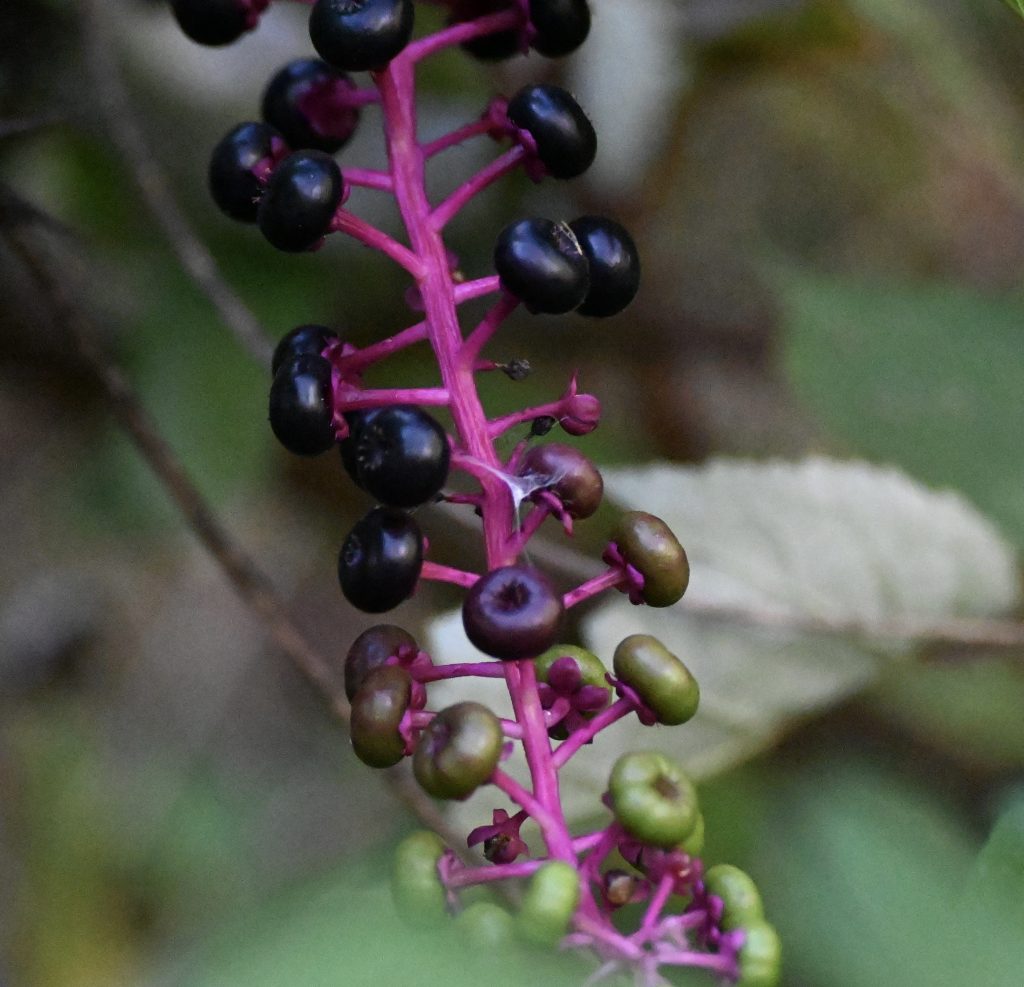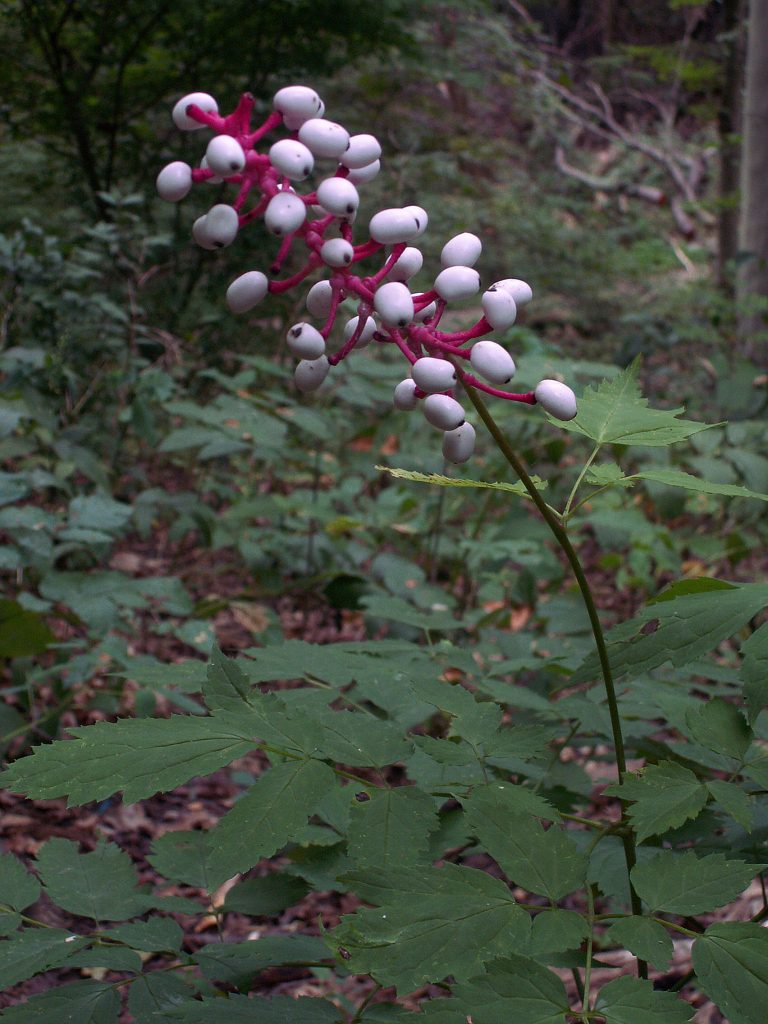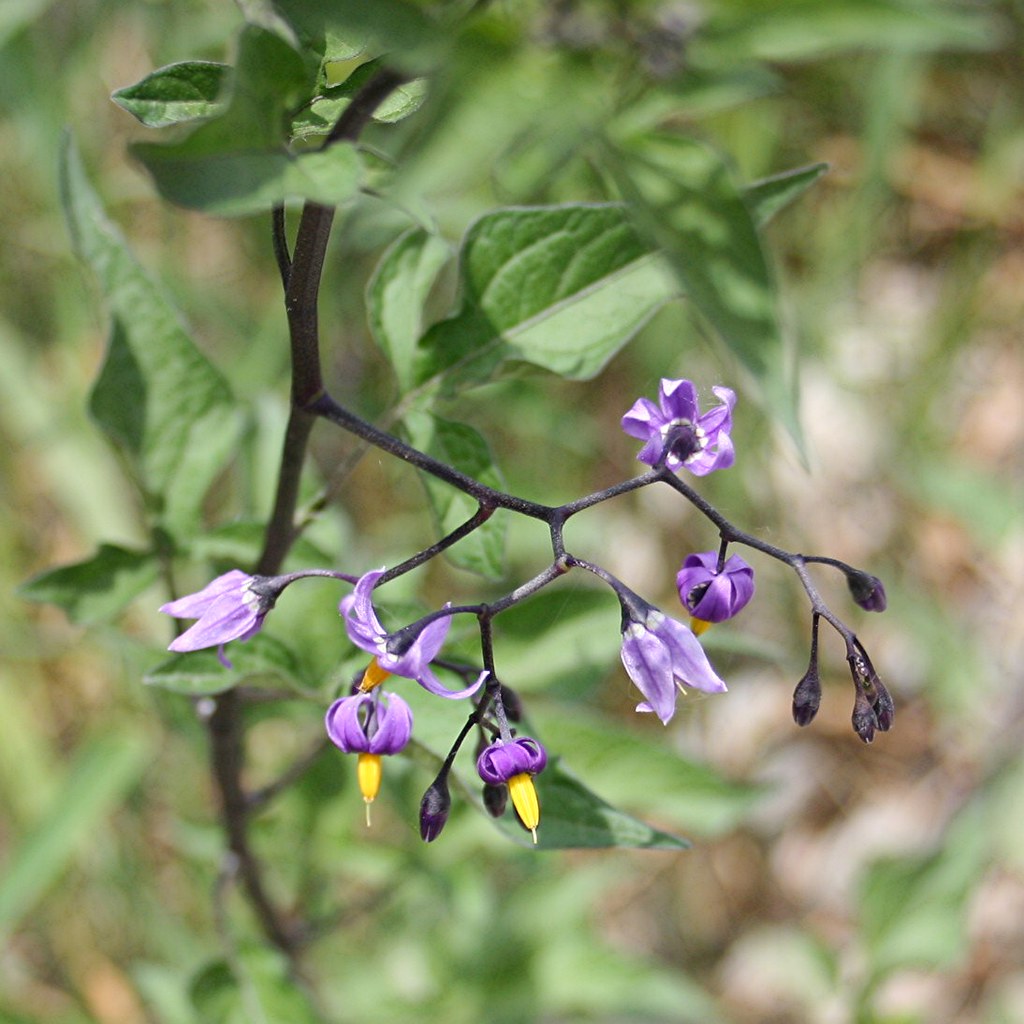
All parts of the jimsonweed plant, especially its leaves and seeds, are toxic to humans. The plant gets its nickname of thornapple from spikey seed pods that form after it flowers. Photo by Joost J. Bakker IJmuiden, CC BY 2.0.
By Caleb Guedes-Reed
In the heart of the Appalachian mountains, where the trees whisper secrets to the winds and the shadows dance with ancient tales, there exists a dark and enchanting world. As Halloween draws near, discover the sinister beauty of four toxic plants that call these mystical mountains home: pokeweed, dolls’ eyes, climbing nightshade and jimsonweed.
Pokeweed (Phytolacca americana)

Although people sometimes boil the young shoots of pokeweed to inactivate toxins, ingesting its berries can be fatal. Photo by Lorelei Goff
Pokeweed, with its striking purple stems and deep-green leaves, can be found lurking along woodland edges and in open fields. Its tempting, grape-like clusters of dark berries, seemingly invite a curious touch. Eating them can lead to severe nausea, vomiting, and in some cases, even death.
A old folktale warns of pokeweed’s malevolent spirit. Lore tells of the plant’s association with magic and witchcraft, especially during Old Christmas, also known as Twelfth Night. Ironically, poke was once cited as the best way to kill a witch, loading a shotgun with its berries.
Dolls’ Eyes (Actaea pachypoda)

The plant known as dolls’ eyes bears innocuous- looking white berries in the fall. All parts of the plant can cause gastrointestinal inflammation and skin blisters. Photo by Cbaile19, CC0 1.0.
Hidden in the gloomy depths of the Appalachian forests, dolls’ eyes are true to their eerie name. Their white, round berries adorned with a single black dot resemble lifeless, staring eyes. These native plants thrive in damp, shaded woods and are a chilling sight to behold.
Tread cautiously, for peril lurks not only within the berries, which, once consumed, can lead to symptoms like gastrointestinal inflammation and skin blisters, but also infests the entire plant. They may look like marshmallow popsicles, but they can kill you.
Climbing Nightshade (Solanum dulcamara)

Climbing nightshade’s reputation as an ingredient in magical blessings and curses extends back centuries. The plant bears red berries in autumn that are toxic to humans. Photo by NRCS Montana, Public Domain Mark 1.0.
Climbing nightshade, also known as bittersweet nightshade, is an invasive vine that winds its way through tangled undergrowth. Its dainty purple flowers and bright red berries are a stark contrast to its frightful reputation. This toxic beauty can be found creeping along tree trunks and shrubs in wetland areas or sprawling along the ground.
The perilous part of the climbing nightshade is its vibrant berries. Ingesting them can cause shock and a host of other unpleasant symptoms. Legends that this vine is a gateway to the spirit world span continents, starting in the plant’s native home in Eurasia and traveling around the world. Witchcraft and folk medicine surround this beautiful vine. During the Middle Ages, climbing nightshade was used to protect animals and was believed to remove a witch’s spell from people. Through these tales, the plant became a symbol of darkness believed to possess mystical powers.
Jimsonweed (Datura stramonium)

Jimsonweed, also known as thorn-apple, bears trumpet-shaped, white flowers and spiny seed pods. Photo by Joost J. Bakker IJmuiden, CC BY 2.0.
Jimsonweed, also known as devil’s snare, is the most toxic of them all. It thrives in the moonlight, hiding among the Appalachian meadows. Its trumpet-shaped, white to purple flowers beckon those who dare to approach, but beware the seeds and leaves of this sinister plant.
Jimsonweed is notorious for causing delirium and depression. In the dark corners of Appalachian and colonial history, British troops concocted a brew, sipping jimsonweed as documented in a 1705 book. Gradually, a madness crept upon them, shrouding their souls in an otherworldly haze. Over time, they descended further into the abyss of their own minds, severing the tether to reality. This torment plagued them relentlessly for 11 long, haunted nights.
As Halloween night descends upon the Appalachian mountains, the tales of these toxic plants come to life. It is a reminder that in the heart of nature’s beauty, there lies a darkness that is both enchanting and perilous.
So, if you wander through the Appalachian wilderness on a moonlit Halloween night, remember to tread carefully and respect the secrets these toxic plants hold. In the shadows of these ancient hills, the line between magic and malevolence is as thin as the veil between the living and the dead.
Did You Know?
If carefully cooked according to a specific process, very young pokeweed leaves and stems are edible and nutritious, and the plant has a long culinary history in Appalachia. But any portion of the root or berries are toxic, and even handling young stems with bare hands can be dangerous.
Although bittersweet nightshade is toxic to humans, its flowers and fruit feed pollinators, birds and some mammals, and its vines provide nesting sites and protective covering.
Most other mammals also find dolls’ eyes berries to be poisonous, but some birds safely eat the berries and disperse the seeds.
In 2008, a study discovered that jimsonweed could be a viable substitute for atropine reserves in hospitals, offering a solution to treat patients in the event of organophosphate exposure, which the researchers noted could occur during a terrorist attack.
Related Articles
Latest News
More Stories

Leave a comment
Your email address will not be published. Required fields are marked *





The British soldiers consumed datura at Jamestown, which is definitely not in Appalachia. (It’s in the VA Tidewater area.) Hence the name “jimson” weed.